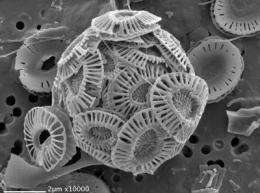Coccolithophore growth and calcification -- a possible role for iron

Lack of sufficient iron may be a significant factor in controlling massive blooms of Emiliania huxleyi, a globally important species of marine algae or phytoplankton, according to research led by researchers at the National Oceanography Centre (NOC) in Southampton.
Emiliania huxleyi is a species of coccolithophore found in oceans all around the world, from the tropics to the Arctic Ocean. Coccolithophore blooms often develop during the summer when a blanket of water called the thermocline develops between the upper mixed layer above and the deep water below.
These blooms can be seen from space as large areas of highly reflective water. This increased reflectivity is caused by shedding of coccoliths, the calcite plates that form the external skeleton or 'shell' of the organism, when nutrients are becoming depleted and the bloom is in decline.
The new research took place during a cruise to the central Iceland basin aboard the Royal Research Ship Discovery during the late summer of 2007, after the main bloom had ended. Measurements of phytoplankton growth, calcification (calcite plate formation), and coccolithophore abundance were made during the trip.
"Our study had two main aims - firstly to measure cell calcification and its variability, and secondly to make comparison between these and environmental conditions so as to help identify those factors that control coccolithophore growth and calcite production during non-bloom conditions," said Dr Alex Poulton of NOC.
The researchers also assessed the dynamics of the coccolithophore community in the central Iceland Basin, in terms of its production, composition, and contribution to the total phytoplankton community.
The researchers found relatively low numbers of coccolithophores and that most of the calcite in the water column was in the form of detached coccoliths rather than whole cells.
From their observations and measurements, along with satellite data on chlorophyll and calcite concentration, they estimated that coccolithophores accounted for around 10-20 per cent of biological production and phytoplankton biomass in sunlit surface waters. Emiliania huxleyi was the dominant coccolithophore present, and both productivity and calcification decreased with depth.
Experiments aboard the ship revealed that both the total number of coccolithophore cells and the variation of calcification rates by individual cells controlled the total amount of calcification by the coccolithophore community. But what factors control this production?
Comparison of cellular calcification rates with the environmental factors currently associated with coccolithophore blooms gave no clear pattern, including sunlight, mixed layer depth, and the availability of nutrients such as nitrate and phosphate.
Instead, the researchers suspect that micronutrients such as iron play an important role in controlling coccolithophore growth and calcification.
This is supported by independent iron enrichment experiments performed by researchers led by Dr Maria Nielsdottir of the University of Southampton's School of Ocean and Earth Science (SOES), based at NOC. Their results, which were published in 2009, indicate that iron availability may exert a strong control on coccolithophore growth and calcification.
Furthermore, Poulton is joining a research cruise this summer (led by Prof. Eric Acterberg of SOES with colleagues from NOC and Portsmouth University) to the North Atlantic, again to examine in greater detail the conclusions of the first two studies - specifically the role of iron in calcification, and the role of zooplankton grazing in controlling coccolithophore numbers.
Finally, calcification by coccolithophores is likely to be affected by ocean acidification caused by increased levels of atmospheric carbon dioxide and its absorption by the oceans.
"Understanding the ecology and production of coccolithophores under both bloom and non-bloom conditions is crucial for assessing how climate change and ocean acidification will affect coccolithophore communities and the important biogeochemical cycles that they contribute to," said Poulton.
More information: Alex J. Poulton, A. J., Charalampopoulou, A., Young, J. R., Tarran, G. A., Lucas, M. I. & Quartly, G. D. Coccolithophore dynamics in non-bloom conditions during late summer in the central Iceland Basin (July-August 2007). Limnol. Oceanogr., 55(4), 1601-1613 (2010).
Provided by National Oceanography Centre, Southampton
















